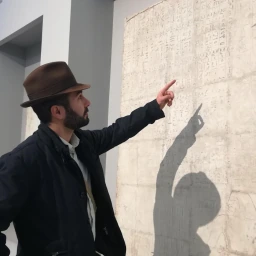Along the Tuscan stretch of the Via Francigena, the ancient route that led pilgrims from France to Jerusalem, lies the beautiful town of Altopascio. Here, before 1084, stood the Spedale “edificatus in locus et finibus ubi dicitur Teupascio“1. Such was in fact the structure used for the sustenance and care of the wayfarers who traveled the adjacent paths. Around this early nucleus was soon established the important religious-chivalric military order known as the Knights of St. James, or simpler Knights of the Tau Cross. Similar to the function that the Knights Templar were having in the Holy Land, they were tasked with escorting and defending pilgrims along the route, providing necessary medicines and improving the road system itself by building bridges or cobblestones. The Altopascio Knights were faithful to the Rule of St. Augustine and chose St. James as their highest protector.

Tau symbology
The choice of dedication to St. James was not accidental: the apostle was the patron saint of pilgrims. One of the most important paths of the Middle Ages was that of Santiago de Compostela in Spain. The Altopascio Knights adopted the symbol of the Tau, which resembles in shape precisely the staff of a pilgrim.
It also connotes several biblical meanings. First, it represents the last letter of the Hebrew alphabet and, therefore, the fulfillment of God’s entire work. Then, in the book of the prophet Ezekiel it is cited that “Go throughout the city of Jerusalem – said the Lord – and put a mark on the foreheads of the men sighing and groaning over all the abominations committed there2” The Tau thus represents a kind of “seal” that identifies God’s elect. Ultimately, the symbol traces the shape of the Cross of Christ.
The Knights of the Tau Cross and the Church of San Jacopo Maggiore
The Domus Hospitalis Sancti Iacobi de Altopassu probably saw the birth of the oldest order of chivalry in Europe. In fact, there are no records of older congregations. This Spedale became an important political and military hub for all of Tuscany. It implemented its territorial possessions and considerable wealth over time. At the end of 1325 it witnessed the clashes between the opposing armies of Florence, which aimed at possession of the palace, and the triumphant army of Pisa-Lucca, the latter under the command of Castruccio Castracani3. The Knights of St. James officially carried out their activities until 1459. However we have reports of their “secrecy” in the following century, when Pope Pius II decreed their dissolution and confiscation of property.

A key center of worship for the Knights of Tau was undoubtedly the church of San Jacopo Maggiore, in Altopascio. The original building, dating from the 12th century, is of clear Romanesque-Lucca inspiration. It is now part of a transept in the massive 19th-century extension. Despite subsequent remodeling, however, the Romanesque facade of the ancient church still retains its unchanging splendor. Here, enclosed among the dichromate bands of the upper order, a statue of St. James appears to greet the pilgrims who still today pass across these fascinating places.
Samuele Corrente Naso


